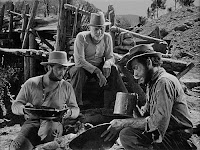You’ve probably heard at least half of this week’s title before. If you’ll indulge me for a bit, I’ll explain the other half.
Since I’ve been waist-deep in the drafting process, I figured I could toss out a rough guide of what that usually means to me. I’ve given lots of suggestions about this sort of thing before, but I thought it might be cool to show a step by step, solid example of how I take a project from a pile of rough ideas to something I’ll show friends, to something I consider worth showing to… well, people who might give me money for it.
Before going into this, I also want to remind everyone of the golden rule.
What works for me might not work for you, and it almost definitely won’t work for that guy.
As I’ve mentioned once or thrice before, we all have our own way of writing. Doing these drafts in this way helps me, but you might need to do something a little different.
That being said…
The 1st Draft— This is just the “get it done” stage, as far as I’m concerned. I don’t worry about catching typos or crafting every subtle moment in the plot. I just want to finish this draft with a beginning, an end, and the majority of points in between.
I tend to skip around a lot in the first draft. I’ll scribble down random beats or dialogue exchanges that occurred to me while the idea was fermenting in my head and drop them more or less where I think they’d go. This serves as a very, very rough outline, just enough so I can start writing on page one and go.
At this early stage, if I get stuck on something (an awkward conversation or complex action scene), I’ll just skip it for now. I know I’ll be able to go into the exact details of Wakko’s nervous breakdown later, so I’d rather keep moving forward and leave those snarls for Future Peter to deal with. Again, for me, the most important thing is to get the overall framework done. It’s a lot easier to think about the little things when the big things aren’t looming over you.
I also don’t hold back here at all. I let dialogue, descriptions, and action scenes go on forever. I know I’ll be cutting eventually, so there’s no reason to worry about length now. For this stage, it really is quantity over quality. I mentioned this visual once before. Think of the first draft like prospecting for gold. If you wanted to find a pound of gold, how much soil would you dig up? Seventeen ounces? Five pounds? Five hundred pounds? Where are your best odds for finding that pound of gold?
I let dialogue, descriptions, and action scenes go on forever. I know I’ll be cutting eventually, so there’s no reason to worry about length now. For this stage, it really is quantity over quality. I mentioned this visual once before. Think of the first draft like prospecting for gold. If you wanted to find a pound of gold, how much soil would you dig up? Seventeen ounces? Five pounds? Five hundred pounds? Where are your best odds for finding that pound of gold?
I don’t show this draft to anyone. My lovely lady may get an out-loud reading or a little peek if I think I’ve done something exceptionally clever. There have been one or two times she’s called me out on something that sounded good in my head but was kind of flat and awkward in someone else’s. I also don’t do much past a night off to celebrate the end of this draft before diving into…
The 2nd Draft— Now it’s time to smooth it out. All those problems I left for Future Peter to deal with need to be dealt with. Gaps get filled in. All those awkward knots get worked out. Because I can see a lot of these elements in relation to the whole story now , I’ll usually find the answers to these problems are more apparent.
The goal with this draft is to have a readable manuscript. No more little notes to myself or trailing paragraphs that need to get connected somehow. Someone should be able to pick this up and read it start to finish without thinking they lost a few pages or only got my notes on a chapter.
Keep in mind this doesn’t mean I do show it to people. It just means I should be able to. Really, the only person who might see this is my lady-love, and not even her always. Sometimes she has to wait.
A few people have argued with me these two drafts really just amount to me doing a first draft in two stages. That may be true, but they’re not writing the ranty blog, are they?
Okay then, so… now I step away for a couple of days. Maybe as much as a week. I’ll watch movies, work out a little extra (I need it after three or four months at my desk), build little toy soldiers, or maybe even scribble up a few ranty blog posts in advance. Sometimes I’ll play with a short story idea. The goal is to push the manuscript as far out of my mind as possible. Don’t look at it, try not to think too much about it. And then…
The 3rd Draft–Stephen King says to start cutting on draft two, but as I said, my draft two is what some people may call a solid first draft. As such, I usually wait until draft three to start slashing. This is where I hunt down adverbs, adjectives, pointless dialogue descriptors, and so on. Two fun rules I’ve mentioned here before–
2nd draft = 1st draft – 10%
one adverb per page, four adjectives
One thing I really go after here is the padding phrases I have a bad habit of dropping in everywhere (sort of, somewhat, kind of, more or less) that don’t really do anything. One of my regular readers dubbed this Somewhat Syndrome, and I like to tell myself I’ve gotten better about it now that I’m aware of the problem. Sometimes I also like to tell myself that Famke Janssen and I would have a really deep, emotional connection if we ever met…
Anyway, at this point I’ve gone through the whole manuscript at least twice, so a few larger cuts should be visible. The long description of Wakko ceremonially sharpening his katana. Dot’s flashback to the summer she lost her virginity during a midnight swim with a handsome stranger. That impassioned speech Wakko gives against taxing the rich. That’s some beautiful writing there, but is it actually doing anything?
This tightening process is also when I can usually spot flaws in the overall structure. In larger stories, it’s not uncommon to end up with “floating” events that are important, but aren’t tied to a solid point in the script. This one may be here right now, but with all of the story in front of me I might realize it would work better there.
If I haven’t already, this is when I let the lady love have a look. She’s my first set of eyes to let me know I screwed up something (10%) and I’m too close to see it.
For the record, this is where Ex-Patriots is right now.
The 4th Draft–This is the first big polish. I go through sentence by sentence, looking for words that come up too often or stilted dialogue. I also make sure all the cuts and swaps from the last draft haven’t messed anything up. Are the logic chains still complete? Transitions still good? Parallels parallel? Arcs smooth? Did Dot just pull a skeleton key out of her pocket that she shouldn’t have yet? Did Yakko just turn into a woman for a few minutes in the middle of the chapter?
This draft doesn’t take long. Just a day or two. It’s just one slow, careful read of the story.
Once I’ve got the fourth draft all shiny, this is the one I show to folks for comments. I generally send it out to five people. They’re a carefully selected bunch, all of whom have some level of literary background, and I don’t think there’s one among them I’ve known for less than five years. One’s actually been reading and critiquing my work for over two decades now, and she still doesn’t cut me any slack. The key thing is they’re all people who will give honest, useful criticism.
This goes off into the world and it may be a month before I look at it again. The trick here is to resist messing with it while those people are looking at it. Again, it’s a great time to flex different mental muscles. Maybe I’ll do a lot of research on an upcoming project. Maybe I’ll build a model tank. Or maybe I’ll just get caught up on laundry.
The 5th Draft— Now I’ve gotten notes back from whatever folks I cajoled into reading this thing. I sit down with all the comments and go through the whole manuscript page by page. This is one of those times that having a second monitor’s very helpful, because I can have three or four versions open and visible at once.
So, what did everyone think of page one? What comments were there on page two? How’s page three look? As I’m doing this, I’ve also got my own copy of the 4th draft that I’m using as a “master document.” This way I can get all the notes assembled in the relevant place and make whatever changes are required. This document is more or less the 5th draft, and it can take another two weeks or more to finish it with a full book manuscript.
I mentioned above that I get five people to make comments for me, and that’s so I can get a broader sampling on each issue that comes up. If four people like something but one doesn’t, odds are I’ll call that good. Nobody’s going to get every joke or like every chapter. If three don’t and two do (and of course I do, or I wouldn’t’ve written it), I’ll sit and give it a good look. And if nobody likes it, well… I’m smart enough to know when I’ve screwed up something doesn’t work.
6th Draft— This one’s yet another smoothing, polishing draft. I need to make sure everything still works now that I’ve made those tweaks and changes from my reader’s notes,. So, yet another line by line reading, adjusting as I go.
And honestly, at this point… this is usually when I’m done. There’s only so much a given writer–in this case, me– can do with a given story. There comes a point when further work accomplishes nothing. If it’s not ready to show to a publisher by now, it probably means I screwed up something big right at the start. Perhaps when I first thought I could adapt To Kill a Mockingbird into a hardcore tween vampire romance starring the Animaniacs.
Y’see, Timmy, there’s a real danger that if you keep trying to come up with reasons to do another draft, you’ll keep finding them. I’m sure we all know someone who’s just been working on the same manuscript for years and years and years because they’ve got another one or two drafts to put it through. After a while of that, your story stops looking like a coherent tale and a bit more like the Frankenstein Monster. And not the nice, clean Boris Karloff version. I’m talking about the seriously messy Roger Corman one.
Maybe even, dare I say it, Mr. Stitch.
Next time it’s going to be Christmas. Well, the Eve of Christmas Eve. So I might prattle on with some ideas about how you can have holiday fun.
Until then, go write
 Lethal Weapon. The Long Kiss Goodnight. Kiss Kiss, Bang Bang. All fun movies, all set at Christmas. What’s interesting to note, though, is that not one of them depends on Christmas for any element of their story. Lethal Weapon is a buddy cop film about taking down drug lords. The Long Kiss Goodnight involves an AWOL assassin trying to stop her old employers. Heck, the most Christmassy part of Kiss Kiss, Bang Bang is Michelle Monaghan walking around for a good chunk of the film in her Naughty Santa costume.
Lethal Weapon. The Long Kiss Goodnight. Kiss Kiss, Bang Bang. All fun movies, all set at Christmas. What’s interesting to note, though, is that not one of them depends on Christmas for any element of their story. Lethal Weapon is a buddy cop film about taking down drug lords. The Long Kiss Goodnight involves an AWOL assassin trying to stop her old employers. Heck, the most Christmassy part of Kiss Kiss, Bang Bang is Michelle Monaghan walking around for a good chunk of the film in her Naughty Santa costume.


